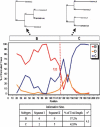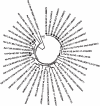Genetic architecture of HIV-1 genes circulating in north India & their functional implications
- PMID: 22310812
- PMCID: PMC3284088
- DOI: 10.4103/0971-5916.92624
Genetic architecture of HIV-1 genes circulating in north India & their functional implications
Abstract
This review presents data on genetic and functional analysis of some of the HIV-1 genes derived from HIV-1 infected individuals from north India (Delhi, Punjab and Chandigarh). We found evidence of novel B/C recombinants in HIV-1 LTR region showing relatedness to China/Myanmar with 3 copies of Nfκb sites; B/C/D mosaic genomes for HIV-1 Vpr and novel B/C Tat. We reported appearance of a complex recombinant form CRF_02AG of HIV-1 envelope sequences which is predominantly found in Central/Western Africa. Also one Indian HIV-1 envelope subtype C sequence suggested exclusive CXCR4 co-receptor usage. This extensive recombination, which is observed in about 10 per cent HIV-1 infected individuals in the Vpr genes, resulted in remarkably altered functions when compared with prototype subtype B Vpr. The Vpu C was found to be more potent in causing apoptosis when compared with Vpu B when analyzed for subG1 DNA content. The functional implications of these changes as well as in other genes of HIV-1 are discussed in detail with possible implications for subtype-specific pathogenesis highlighted.
Figures




References
-
- Simoes EA, Babu PG, John TJ, Nirmala S, Solomon S, Lakshminarayana CS, et al. Evidence for HTLV-III infection in prostitutes in Tamil Nadu (India) Indian J Med Res. 1987;85:335–8. - PubMed
-
- NACO (home page on the internet). HIV Sentinel surveillance and HIV estimation in India. 2007. [accessed on May 13, 2009]. Available from: http:// www.nacoonline.org/upload/Publication/M&E%20Surveillance,%20Rese... .
-
- Lakhashe S, Thakar M, Godbole S, Tripathy S, Paranjape R. HIV infection in India: epidemiology, molecular epidemiology and pathogenesis. J Biosci. 2008;33:515–25. - PubMed
-
- Singh HK, Gupta A, Siberry GK, Gupte N, Sastry J, Kinikar A, et al. The Indian pediatric HIV epidemic: a systematic review. Curr HIV Res. 2008;6:419–32. - PubMed
-
- Kandathil AJ, Ramalingam S, Kannangai R, David S, Sridharan G. Molecular epidemiology of HIV. Indian J Med Res. 2005;121:333–44. - PubMed
Publication types
MeSH terms
Substances
LinkOut - more resources
Full Text Sources
Medical
Molecular Biology Databases
